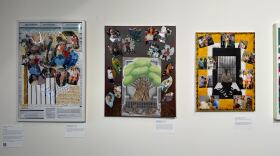The first time Thomas Jefferson Kitts went to the Maryhill Museum of Art near Goldendale, Wash., he’d just returned to the Northwest from art school in Kansas City. It was a hot day outside, but he found relief in the quirky museum on a cliffside of the Columbia River.
“I was really surprised, somewhat blown away, by what I saw there. So, I just kept showing up every now and then to see what showed up on the wall,” Kitts said.
This year, it’s his art gracing the space.
“It was kind of a coming home story for me,” Kitts said.

The museum’s newest exhibit, “The Columbia River: Wallula To The Sea,” features works by Kitts and fellow artist Erik Sandgren, both based in Portland. Around 70 historic and contemporary paintings and photographs displayed there depict the middle and lower sections of the Columbia.
The exhibit features many “plein air” paintings, which loosely translates to “out in open air.” The paintings showcase a roughly 313 mile stretch of the mighty Columbia. With “plein air” painting, the light and conditions constantly change.
“We're bringing the Columbia River Gorge to the world,” said Amy Behrens, Maryhill Museum of Art CEO. “We want people to come and reflect on the identity of the river and to chronicle the ways that humans have interacted past and present with the river. And, to think about what the future of the river means.”
It’s the perfect place for a “plein air” exhibit, she said, with the museum situated on a bluff on the side of the river, right near the scenic gorge.
“It really brings the inside out and the outside in,” she said. “This is really an exhibit that is about the people that have lived here.”
As a companion to the main show, the museum also is featuring wood and linocut prints in a show called “King Salmon: Contemporary Relief Prints.” The prints are part of the museum’s permanent collection and depict chinook salmon and their cultural importance.
Both exhibits will be on display through Nov. 15.
Sandgren moved to the area in the 1980s. He said the exhibit also illustrates the cultural changes that have happened as the river has changed.
“One of the things that one learns about the river is how industry has been beavering away for the last 200 years,” Sandgren said.
He said farming and industry, dikes and dams, have all changed the contour of the river.
Each painting, Sandgren said, was a personal form of land acknowledgment.
“It's really quite an amazing place where you sense the vastness of this rather harsh environment, especially east of the mountains, cold winters, hot summers, lots of wind and grit,” Sandgren said. “I became very conscious of certain features of the landscape, which are featured in Indigenous myths, legend and origin stories.”
Sandgren described his paintings as both “plein air” and “partly an invented imagined and remembered experience of the landscape that I know so well.”
He said his most creative work in the show is a tall and narrow panel split into four pieces that Sandgren said represents all the portions of the river in the exhibition. The piece is inspired by classical Chinese art.
“I was able to frame the stretches of the river between the Twin Sisters of the Confederated Tribes of the Umatilla Indian Reservation at one end with Swallalah-oost, or Saddle Mountain, at Astoria as the river meets the sea,” he said.
Kitts said he fell in love with “plein air” painting at an early age, fresh out of school.
“When you're outside, you're in it,” Kitts said. “Your eyes can see so much more than any camera can capture. All your senses are filled: you hear things, you see things, you smell things. It's a much more visceral experience.”
He described his work as eclectic at times, noting one of his favorite pieces in this show is a 24-by-48-inch historic painting. It depicts Hudson's Bay Company fur trappers, who were in the area in the early to mid-1800s.
“I have a friend who is specialized in that period and this area,” Kitts said. “He had some old photographs of him and six of his friends in period costumes. I mean, this is very historic, getting into a birch bark canoe and pushing off shore near Beacon Rock.”
The show also depicts the connection to the environment and the history of the Columbia River, which is the fourth largest river in North America by volume of water, Kitts said.
“People can really revel in the overarching history of the Columbia River,” he said. “People from other parts of the country don't understand the majesty and scale of what is out here.”
Copyright 2024 Northwest News Network. To see more, visit Northwest News Network. 9(MDAyNTQ1NzQ1MDEyMjk0OTcxNTI4MzljZQ001))






